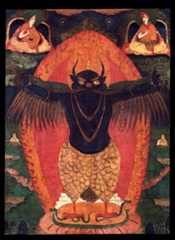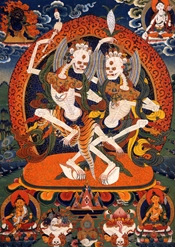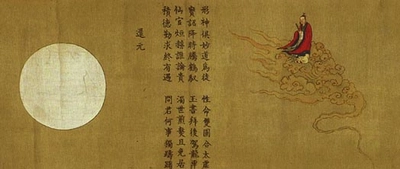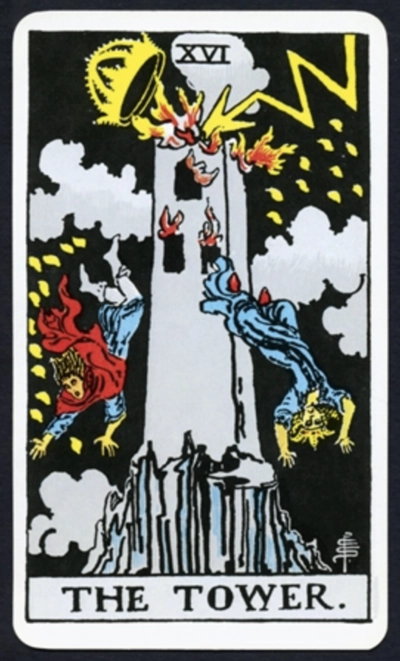ARAS Connections: Image and Archetype - 2014 Issue 4

We are just beginning to see the fruits of our initiative to grow the ARAS archive by including new images and developing the commentaries that place the images in cultural and archetypal context. To remain alive and vital, the archive needs to continue to grow its collection, especially in the areas in which we are underrepresented, including our collections of African, Asian, MesoAmerican, and Australian Aboriginal images. In this edition of ARAS Connections, we are excited to preview new material from Australia and from Tibet. Such material does not grow on trees; to create new files, we need individuals with a passionate interest in specific images along with the the commitment of time and energy to conduct the scholarly research that makes the ARAS archive and its files a uniquely valuable resource. Craig San Roque is taking a first, huge step in adding to the Aboriginal collection and Chantal Lee and Giada Shaver have contributed three sensational new files on Tibet.
Craig San Roque, a Jungian analyst living in Alice Springs, Australia, has agreed to take on the leadership of developing the aboriginal section of ARAS. Some of you may be familiar with Craig's previous contribution to Online ARAS. Along with the artist Joshua Santospirito, Craig has created the first ever Jungian graphic novel, The Long Weekend, a story about life in Alice Spring which can be found on ARAS here. The imagery of aboriginal Australia is a living tradition and, as with any symbolic material, needs to be approached with the greatest sensitivity and respect for those who create it and for whom it remains an essential part of knowing who they are and how they fit into a larger scheme of things. That is how Craig has approached this exciting new ARAS project and it is our hope that this is the first of many future Aboriginal contributions to ARAS Connections and the ARAS Online archive itself.
The same can be said of Chantal Lee and Giada Shaver, both of whom worked with the Rubin Museum of Himalayan Art in New York and are volunteers at National ARAS. They are models for what we hope will become a more common route for symbolic imagery and commentary to find its way to the ARAS archive, namely through the efforts of dedicated, independent scholars from around the world willing to submit symbolic imagery/commentary to ARAS. To develop a file for ARAS is not a simple undertaking as it requires both a passion for the image itself and the willingness to undertake a serious, scholarly study of the cultural context of the images and their symbolic meaning. Images flood the internet but ARAS is a unique online site in that it not only features imagery from around the world but explores that imagery in terms of its archetypal, psycho-spiritual underpinnings. As independent scholars, Chantal and Giada have taken three striking Tibetan images and provided a symbolic context that gives them meaning in terms of our being able to approach the images with curiosity, intelligence, and reverence. We are deeply grateful to them for their contribution and for setting a standard for how others may contribute in the future to growing the ARAS archive in the future.
Tom Singer
Co-editor of ARAS Connections



Living people - Living language - Living symbol

Craig san Rogue is a Jungian analyst living in Alice Springs where he works with Aborigines on a variety of social, political, artistic, spiritual, and mental health issues. His essays have appeared in The Cultural Complex and Placing Psyche. His chapter from The Cultural Complex was made into the world’s first Jungian graphic novel in collaboration with Joshua Santospirito and won a major Australian literary award for its creative contribution to the wellbeing of Australia. San Roque has created other innovative and highly imaginative cross-cultural projects , including authoring Sugarman that adapts the myth of Dionysus to the situation of Aborigines who have nothing in their dream time or mythology to deal with alcoholism and petrol sniffing which only arrived with the white immigrants to Australia. In addition, he has adapted the Demeter/Persephone myth to help the Aborigines make the transition from a hunter-gatherer society to an agricultural society. Again, nothing in their dream time speaks to mysteries of agriculture that are unfamiliar to the aborigines.
- Tom Singer
‘Wanampi is there, you don’t see him with your eyes, like ordinary things, but you know he is there, you feel him there, you can feel him moving.’
Indigenous woman describing the movement of a Jukurrpa snake at a specific site in central Australia. July 2014.
The ARAS site gathers images and symbols from many of the worlds’ peoples and cultures. ARAS serves as a cultural custodian. ARAS is a modern way of preserving and protecting the memory of our beloved cultures. It is timely for ARAS to help protect indigenous cultural forms. Many of those forms are of ancient origins.
ARAS is now beginning to look into the ways to respectfully include images and patterns from some of the most ancient living traditions in the world. These are people of Australasia. The ARAS Board has been patient and cautious, waiting until natural human relationships have been established with people who are directly involved in the Australian indigenous culture.
It may be true to say that for many of the images (from the Northern Hemisphere) collected in the archive, there are no known, personally remembered individuals alive who designed the symbolic forms now nesting in the archive. The images are inherited and may be present to us, but the persons who created those images are no longer living.
Such original peoples may have lived thousands of years ago in the Caucasus, the Tigris basin, the Danube or on the islands of Crete. They have left behind their imagery - but they cannot be spoken to directly - “What do you mean by that image and how do you use it in story, ceremony or initiation?” Though in some cultures the living thread is tended and passed on, many connections in the thread of memory have broken in the course of thousands of years; and so we have the images from the past without the living custodians who made those images.
The situation in present day Australia is unusual. The people who are custodians of the symbolic languages of Australian first peoples are alive and continually engaged in relationships with the creatures, objects, movements and terrain that form the symbolic language of Australian indigenous tribal groupings.
In Australia, the people who make the images are living people and though some may live in fraught, fractured and embattled conditions, the tradition and lineages of meaning are in existence. It is possible to talk with the people who make the images and tell the stories; it is even possible to enquire respectfully, cautiously, personally into the meaning and intent and use of symbolic objects, actions, narratives, images.
It is has been reassuring for me, (a Jungian Analyst and community mental health worker in remote Australia ) to discover that the symbolic and ceremonial forms of Australian indigenous peoples are alive and active in the present, and these forms can be drawn upon with healing intent. While I recognize at the same time that the memory and practice of those forms is fading or changing, or being rediscovered.
ARAS would like to introduce you to Australia through some of the people who we know personally. We do this by courteously introducing people who we hope you will get to know through the ARAS site. In this first entry of Aboriginal material into ARAS Connections we bring you some works from Andrew Spencer Japaljarri and family and the Warlukurlangu Art Gallery in Yuendumu, central Australia. If you take the trouble to go to the Warlu website you will meet some notable artists and glimpse the iconography of the Warlpiri. Warlukurlangu Artists Gallery has graciously agreed to partner ARAS on this project.
Read Living people - Living language - Living symbol in it's entirety.
Give to ARAS!

We received the following statement from an ARAS Online member, donor and friend, describing why giving to ARAS is important to him.
"ARAS is a treasure house, rich in detail and variety, matched by the spectrum of users who come to visit—from dreamers and their analysts, who wish to explore the archetypal language of the unconscious, to marketing designers looking for just the right symbol to brand their products. Online and on premises, ARAS is an unparalleled resource. Having the good fortune to be able to easily visit one of their physical libraries offers the personal dimension of being welcomed by warm and informed guides to the archive who help make this extraordinary library a pleasure to work in. They make one feel like an old friend. ARAS, in either dimension, is vast in its offering and, at the same time, a small operation that thrives on the creative energy of its staff and financial support of its users. I’m happy to be a friend, and give what I wish in return." – Royce Froehlich
Please join Royce and others like him in supporting ARAS as generously as you can. Click here to donate.
With deep appreciation for your interest in ARAS Connections, it is my great pleasure to let you know what is happening at ARAS. This year has been extraordinary, full of new adventures. We hope you have all explored our beautiful new website, which makes research navigation and adding new material easier. We are very excited about being able to add 200 new images of African art with accompanying texts, generously donated from the Bareiss family art collection. And thanks to a generous grant from The Bay and Paul Foundation, another 300 images will soon be added to areas in the Archive that need to be filled out. Transferring the carefully selected 740 images and inspiring texts from The Book of Symbols to the online collection will bring more treasures to the archive files. We are also very close to having numerous universities, museums and libraries access the online Archive through our partnership with ARTstor. Meanwhile, their tremendous Digital Library is already available for ARAS online members. We continue to publish articles from the 2012 “Art and Psyche in the City” conference held at New York University, here, in ARAS Connections. ARAS continues to offer Ekphrazein events with young poets presenting poetry inspired by an archetypal image from the Archive. We hosted an unforgettable two-week summer workshop called Pioneer Teens during which nine teens researched a symbol that felt important to them and created art inspired by their symbol in a joyous atmosphere of partnership and creativity. Four of the teens are now working as interns at ARAS, and their enthusiasm continues to add a lovely youthful spirit to the Archive.
To continue our many exciting projects we need your help even more than ever before. We hope that all of you will give as generously as you can. When you give to ARAS, you invest in imagination.
Sending you all good wishes for the holiday season!
Ami Ronnberg
Interview: Ami Ronnberg – curator of ARAS and editor-in-chief of Taschen’s Book of Symbols

Originally published on GettyImages.com
Housed in a building in midtown Manhattan is a most unusual library that traffics in dreams and images accompanied by texts. Here you’ll find books about myths and a card catalog that has drawers full of symbolic themes instead of the usual Dewey Decimal reference numbers. ARAS, or the Archive for Research in Archetypal Symbolism, is a repository of symbols: a space both in the physical world and online, where one can study archetypal imagery, based on psychoanalyst Carl Jung’s theory that images are the universal language of the collective unconscious.
A 30,000 year-old sculpture made of mammoth ivory.
Hohle Fels, Ach River Valley, Germany
Why do swans keep showing up in your mind as you sleep? Are you writing a story about a battle, or working on a campaign with a jester as its main character? A visit to ARAS can help you meditate on these images and more, teaching you about the occurrence of these archetypes throughout world culture over time, and inspiring you to mull over their meanings.
Getty Images’ Visual Trends Director, Pam Grossman, chats with Ami Ronnberg, curator of ARAS and editor-in-chief of The Book of Symbols about how archetypal imagery influences human creativity in art and commerce.
PG: Can you talk a little bit about what archetypes are and why archetypes matter?
AR: Archetypes can be described as the structure of the psyche and they are also what makes each one of us unique. Archetypes can never be known directly – we only know of them through symbols or archetypal images. They are universal expressions of human experience and reach back to the dawn of mankind.
The Poetry Portal

We thank you for your submissions of poetry to the Portal and I am delighted that many of you felt the inspiration to write about the paths that we travel along life’s journey. Here are some of the submissions that we received. As we near the end of 2014, we are on the threshold passing through the great doors to the New Year. I have such wanting for its possibilities and yet such uncertainty.
NOT knowing when the dawn will come
I open every door;
Or has it feathers like a bird,
Or billows like a shore?
These lines of verse from Emily Dickinson encourage us to be seekers, to be brave and in the three images that we have chosen for Doors, encourage you to be expansive. To open every door, whether they are the Baptistery doors of Firenze, the door of the stranger coming through, or the gates of the Shinto Shrine calling all the kami forth. We invite you to write and send your most beloved poems. I encourage you as Krishnamurti, “…to look and learn, the door is there and the key is in your hand.” As you enter through the gates and doors of the New Year. We hope you will send your poems to info@aras.org by February 15th.
Contents
Become a Member of ARAS!
Become a member of ARAS Online and you'll receive free, unlimited use of the entire archive of 17,000 images and 20,000 pages of commentary any time you wish—at home, in your office, or wherever you take your computer.
The entire contents of three magnificent ARAS books: An Encyclopedia of Archetypal Symbolism, The Body and The Book of Symbols are included in the archive. These books cost $330 when purchased on their own.
You can join ARAS Online instantly and search the archive immediately. If you have questions, please call (212) 697-3480 or email info@aras.org
We Value Your Ideas
As our newsletter grows to cover both the ARAS archive and the broad world of art and psyche, we're eager to have your suggestions and thoughts on how to improve it. Please send your comments to info@aras.org. We look forward to your input and will reply to every message.
Subscribe
If you're not already a subscriber and would like to receive subsequent issues of this newsletter by email at no cost, e-mail us at newsletter@aras.org.
